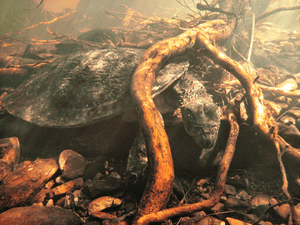Fitzroy River turtle facts for kids
Quick facts for kids Fitzroy River turtle |
|
|---|---|
 |
|
| Conservation status | |
| Scientific classification | |
| Genus: |
Rheodytes
|
| Species: |
leukops
|
| Synonyms | |
|
|
The Fitzroy River turtle (Rheodytes leukops) is a special type of freshwater turtle. It's the only living member of its group, called Rheodytes. You can only find this turtle in southeastern Queensland, Australia. Its home covers an area of less than 10,000 square kilometers. This includes the Fitzroy, Mackenzie, and Dawson rivers.
Contents
What Does the Fitzroy River Turtle Look Like?
The Fitzroy River turtle can be light to dark brown. It grows to about 260 millimeters (about 10 inches) long. This measurement is for its carapace, which is the top part of its shell.
Baby turtles, called hatchlings, have shells with jagged edges. These shells can be up to 95 millimeters long. Adult turtles have smooth, rounded shells. The skin on their necks has small bumps. These bumps can be blunt or pointy. The turtle also has a pair of small whiskers, called barbels, on its lower jaw.
One amazing thing about the Fitzroy River turtle is how it breathes. It can get up to 70% of the oxygen it needs from the water. It does this using a special part of its body called the cloaca. Because of this, the Fitzroy River turtle can stay underwater for up to three weeks!
How Does the Fitzroy River Turtle Live?
What Does the Fitzroy River Turtle Eat?
This turtle is a bottom feeder. This means it finds its food at the bottom of the river. It eats many different things. These include insects that live on land and in water. It also eats small creatures without backbones, like crustaceans. Other foods are algae, aquatic snails, worms, freshwater sponges, and water plants.
Where Do They Live and How Do They Behave?
These turtles prefer water that flows quickly. They especially like areas near sand banks, where they lay their eggs. They have been found in water as shallow as 15 centimeters (about 6 inches).
Most of the time, people find them lying still. They hide under plants hanging over the shallow banks. They also hide in fast-flowing parts of the river, called riffles. Sometimes, they hide under logs in the water.
How Do Fitzroy River Turtles Reproduce?
It can be tricky to tell male and female Fitzroy River turtles apart. The female's tail is shorter than the male's. But the best way to tell is by looking at the distance between certain parts of their shell and their cloaca. In males, the cloaca is further away from the bottom shell (plastron) than in females. Most other short-necked turtles in Australia have more obvious differences in tail length and thickness.
Protecting the Fitzroy River Turtle
The Fitzroy River turtle has been listed as a vulnerable species since 1994. This means it is at risk of becoming endangered. Both Australian laws, like the Environment Protection and Biodiversity Conservation Act (EPBC Act 1999), and Queensland's Nature Conservation Act, 1992, protect it.
The main dangers to the Fitzroy River turtle are:
- Less oxygen in the water.
- Fewer prey animals for them to eat.
- Their habitat changing from fast-flowing rivers (fluvial) to more lake-like areas (lacustrine).
- More sand and mud building up on the river floor. This makes it harder for them to breathe using their cloaca.


